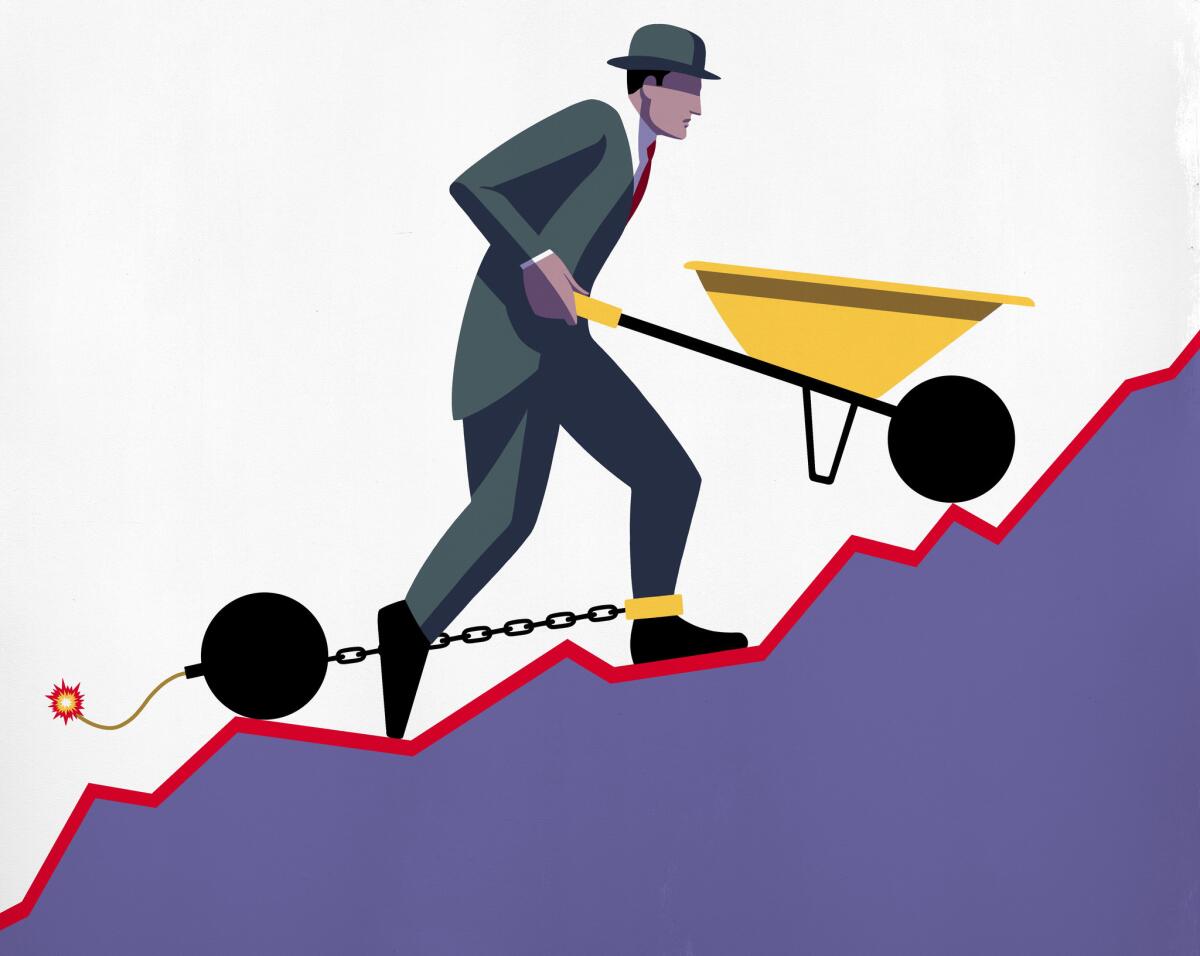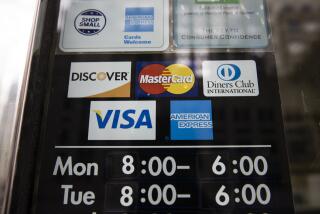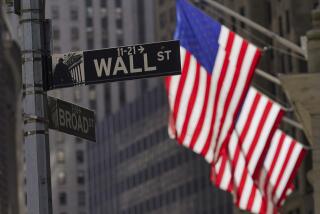Remember the subprime mortgage mess? $1.2 trillion in risky corporate debt is flashing similar warning signs

- Share via
Reporting from Washington — Indebted borrowers increasingly take out high-interest, adjustable-rate loans that are packaged into securities and sold to investors eager for a better rate of return.
Everything’s fine while the economy is growing. But when it slows, those borrowers could default, causing problems to cascade through the financial system.
If this all sounds like the subprime housing market in the boom years before the 2008 financial crisis, you’re right. And that’s what increasingly has regulators, lawmakers, ratings agencies and some market watchers worried.
This time, however, the borrowers in this credit bubble aren’t homeowners taking out mortgages. They’re hundreds of U.S. companies with weaker credit ratings, many of them well-known like Uber and Burger King, taking out so-called leveraged loans.
Those loosely regulated loans often are used to fund corporate deal-making. But those deals, known as leveraged buyouts, can go bad because of the large debt load, as happened with the demise last year of Toys R Us.
Combined, there is about $1.15 trillion in outstanding U.S. leveraged loans — a record that is double the level five years ago — and those loans increasingly are being made with less protection for lenders and investors.
“Any fair-minded look at the leveraged loan market should cause significant alarm by anybody concerned about financial stability and the inevitable upcoming economic downturn,” said Dennis Kelleher, president of Better Markets, a group that advocates stricter financial regulation. “You put all these pieces together, it’s a witches brew.”
The risks aren’t nearly as widespread as they were during the housing bubble, when the percentage of all mortgages that were subprime jumped to about 20%. Leveraged loans, while growing rapidly, account for less than 5% of the more than $42-trillion U.S. fixed income debt market, which also includes corporate and municipal bonds.
Still, the Federal Reserve, the Office of the Comptroller of the Currency, the Bank of England, the International Monetary Fund and the Bank for International Settlements — a consortium of 60 central banks — all have raised concerns recently about the growth of the leveraged loan market and the potential risks to the financial system in an economic slowdown.
Former Federal Reserve Chairwoman Janet L. Yellen went public this fall with her worries about what she called a “huge deterioration” in the standards for those loans, which make it easier for indebted companies to take on more debt.
“If we have a downturn in the economy, there are a lot of firms that will go bankrupt, I think, because of this debt,” she told the Financial Times. “It would probably worsen a downturn.”
And presumed Democratic presidential candidate Sen. Elizabeth Warren (D-Mass.) is pressing U.S. regulators for answers about oversight of the market.
“I am concerned that the large leveraged lending market exhibits many of the characteristics of the pre-2008 subprime mortgage market,” she wrote in a November letter to key regulatory agencies.
Even Jamie Dimon, chief executive of JPMorgan Chase & Co., who last week dismissed concerns that the leveraged loan market represented a potential “systemic risk,” warned that there could be problems for some lenders outside the conventional banking system.
“Someone’s going to get hurt there,” Dimon said on a Tuesday earnings call, referring to leveraged loan losses if a recession hits.
Toys R Us loaded up on leveraged loan debt when it was purchased in a leveraged buyout in 2005 by private equity firms Bain Capital and KKR & Co. and real estate investment trust Vornado Realty Trust. The debt burden led the toy retailer to file for bankruptcy protection in 2017 after it was unable to refinance the debt.
Burger King used a $6.75-billion leveraged loan to help fund its 2014 purchase of Tim Horton’s, the Canadian coffee and doughnut chain. And Uber last year raised $1.5 billion in its second leveraged loan issuance, following a $1.15-billion one in 2017, according to the Wall Street Journal.
Leveraged loans in and of themselves aren’t bad. They are simply a credit instrument employed with companies that already have a lot of debt. And those firms are fairly common.
About two-thirds of U.S. companies have enough debt that independent credit raters have them categorized as a higher risk to repay than companies with so-called “investment-grade” ratings, which makes them off-limits to many institutional investors.
Because those companies with non-investment-grade ratings are highly leveraged, the chances are greater that they won’t pay back a loan. For that reason, the interest rate needs to be higher to offset that risk. The higher interest rate makes the loans desirable to investors seeking a greater return on their money.
The Fed’s benchmark federal funds rate is now at a range between 2.25% and 2.5%. The yield on 10-year Treasury bills is about 2.8%. But yields on leveraged loans can be higher than 10% if an investor buys into the riskiest and most speculative segment of the market. Safer leveraged loans can still pay several points higher than a Treasury bill.
In those ways, leveraged loans are similar to the junk bonds that became popular in the 1980s and fueled corporate deals. But there’s an important difference.
Junk bonds — those rated below investment grade by ratings companies — are securities that are traded under the oversight of the Securities and Exchange Commission. Leveraged loans are basically private transactions between lenders and borrowers, so they are not regulated by the SEC.
However, bank regulators do keep tabs on the underwriting standards and outstanding loan totals of banks to make sure if loans go sour, they won’t have to step in and rescue the institutions — which is what happened during the financial crisis — and they are starting to raise flags.
In its semiannual risk report issued last month, the Office of the Comptroller of the Currency, which regulates national banks, said it “remains attentive to the heightened risks in the corporate bond and loan markets, and in particular, the leveraged lending market.”
And in its financial stability report in November, the Fed said that although default rates for leveraged loans remained low, “credit standards for new leveraged loans appear to have deteriorated over the past six months.”
The share of newly issued large loans to companies with high ratios of debt to adjusted earnings “has increased in recent quarters and now exceeds previous peak levels observed in 2007 and 2014 when underwriting quality was notably poor,” the Fed report said.
Kelleher said the decline in lending standards was troubling.
“You have the leveraged loan market growing at a very rapid clip at the same time the standards are dropping,” he said. “The leveraged loan market is flashing red warning lights all over the place.”
Those are Warren’s concerns as well. She said in her November letter that federal regulators appointed by President Trump appear to have backed off guidance issued in 2013 by Obama-appointed regulators urging banks to use tougher underwriting standards for leveraged loans.
Federal Reserve Chairman Jerome H. Powell has expressed less concern, saying in September that the direct risk to banks from leveraged loans is limited because of restrictions on their lending now in place.
“That market has evolved really significantly since before the crisis,” he said. “But it’s also true … that excessive risk-taking in the leveraged lending markets does have channels for affecting the real economy, if there’s overheating and that kind of thing in those markets, so we monitor that carefully.”
However, there is a concern that with regulated banks offering fewer such loans there is less oversight of the leveraged lending market in general.
The share of leveraged loans offered by large banks has declined from about 80% in 2010 to about 54% this year, while the share of those loans offered by small banks and nonbanks has increased to about 46% this year. Among the lenders outside the banking system making leveraged loans are private equity firms, hedge funds and insurance companies.
Lenders package these loans into securities called collateralized loan obligations that are sold to investors, freeing them up to make more loans. What’s more, these loans increasingly are being offered with fewer restrictions on repayment, making them more attractive than junk bonds as a source of corporate financing.
Bloomberg reported this fall that total outstanding leveraged loans had overtaken junk bonds “to cement their status as the go-to financing source for speculative grade companies.”
“Because the loan market got so attractive, we ended up seeing a lot more companies going to the loan market,” said Christina Padgett, head of leveraged finance research at ratings firm Moody’s Investors Service. “Companies can borrow a bunch of money relatively affordably, do what they want to do with relatively little constraints and still service their debt.”
Further fueling the growth in leveraged loans were the near-zero interest rates put in place by Federal Reserve officials during and after the Great Recession to try to spur economic growth.
The effect of those low rates rippled through the financial system. They lowered the cost of borrowing to make it more attractive to companies seeking to make acquisitions or refinance their debt — even if they had to take out a leveraged loan.
The low rates set by the Fed also made owning a piece of a leveraged loan a more attractive investment that paid a higher return than other debt instruments. It also came with the promise of adjusting up when the Fed began lifting its own benchmark rate.
“Investors are desperate for yield — we’ve seen this show before — so they’re not demanding a lot in terms of investor protections,” said Sheila Bair, who headed the Federal Deposit Insurance Corp. during the financial crisis. “You lower interest rates on safe assets, these are the incentives you get.”
Concerns also have been raised about a ruling last year by a three-judge panel of the U.S. Court of Appeals for the District of Columbia that removed a regulatory restriction on collateralized loan obligations.
The 2010 Dodd-Frank financial reforms sought to reduce the sale of risky investments by requiring firms that package loans into securities to retain a 5% stake in the investment. The Loan Syndications and Trading Assn., a leveraged lending industry group, filed suit, arguing the requirement could limit funding.
After losing in a lower court, the group won a ruling from the appeals court panel in February.
The Loan Syndications and Trading Assn. has downplayed the risks in the market.
The group notes that leveraged loans make up a small percentage of the U.S. fixed-income debt market. And the overall default rates on leveraged loans are low — just 1.6% late last year and forecast by Fitch Ratings to fall to 1.5% at the end of this year.
But with U.S. economic growth slowing, the dynamics could change.
“Every time the economy slows down, you see a pickup in defaults,” Bair said.
Fed monetary policy makers estimated in December that they would enact two more small hikes in their key interest rate this year, although Powell said recently that they would be “patient and flexible” as they monitor the economy.
Higher rates would put more pressure on the leveraged loan market. But a sharp economic downturn could lead the Fed to lower rates, which would ease the pressure.
“When you’re this late in the business cycle, you have pretty much already lent to every creditworthy borrower,” Kelleher said. “The real question is, how much lending do you want to give to marginal, non-creditworthy borrowers?”
More to Read
Inside the business of entertainment
The Wide Shot brings you news, analysis and insights on everything from streaming wars to production — and what it all means for the future.
You may occasionally receive promotional content from the Los Angeles Times.











